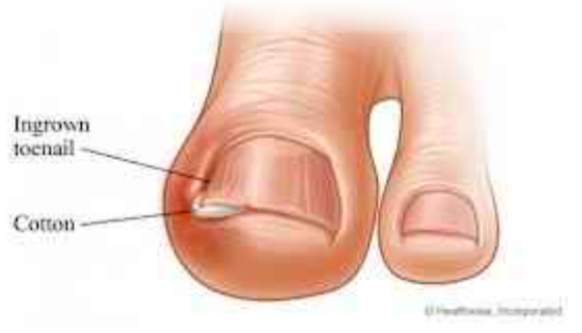Ingrowing Toenails
One of the most common foot disorders is an ingrown toe nail. The edge of the nail grows into the skin at the side of the nail, and the area becomes infected. The skin is red and inflamed, and the toe hurts. Pus may form.
Major factors which can cause the problem are:
- Tight shoes
- Tight socks
- Cutting the nail too short with rounded edges
Treatment
An ingrown toenail can often be effectively treated by antibiotics, surgical removal of a wedge of nail, avoiding tight shoes and tight socks and avoiding improper Post operation cutting of toenail.
Post operation a bulky dressing will be applied to the A chronic ingrown toenail with recurrent infections may toe. This should not be removed for 7 days. You will not require surgery. be able to drive yourself. Please make arrangements for transport home in advance.
Surgery
Please keep your foot elevated above the level of your heart as much as possible for 72 hours after surgery as With a wedge resection of the nail, the surgeon removes this will reduce swelling and bleeding – both of which a strip of nail at the side and a small part of the nail bed. may increase the risks of local infection.
The nail will then grow straight and not grow into the skin. You need to ensure that you have an appointment 7-10 days post-op so that the dressings may be reduced Usually one edge of the nail is removed. In some cases and any sutures removed both left and right edges are removed.
To treat severe cases the surgeon may need to remove Complications the whole nail and the complete nail bed.
These include:
The surgery is a day-case procedure.
- It may be Infection
- Performed under local anaesthetic or general
- Recurrence of ingrown nails anaesthetic
Medical Team
DR. PRADEEP MONOOT
MBBS (Bom), MS (Ortho)(Bom), DNB (Orth), MRCS (UK), FRCS (Ortho) (UK)


